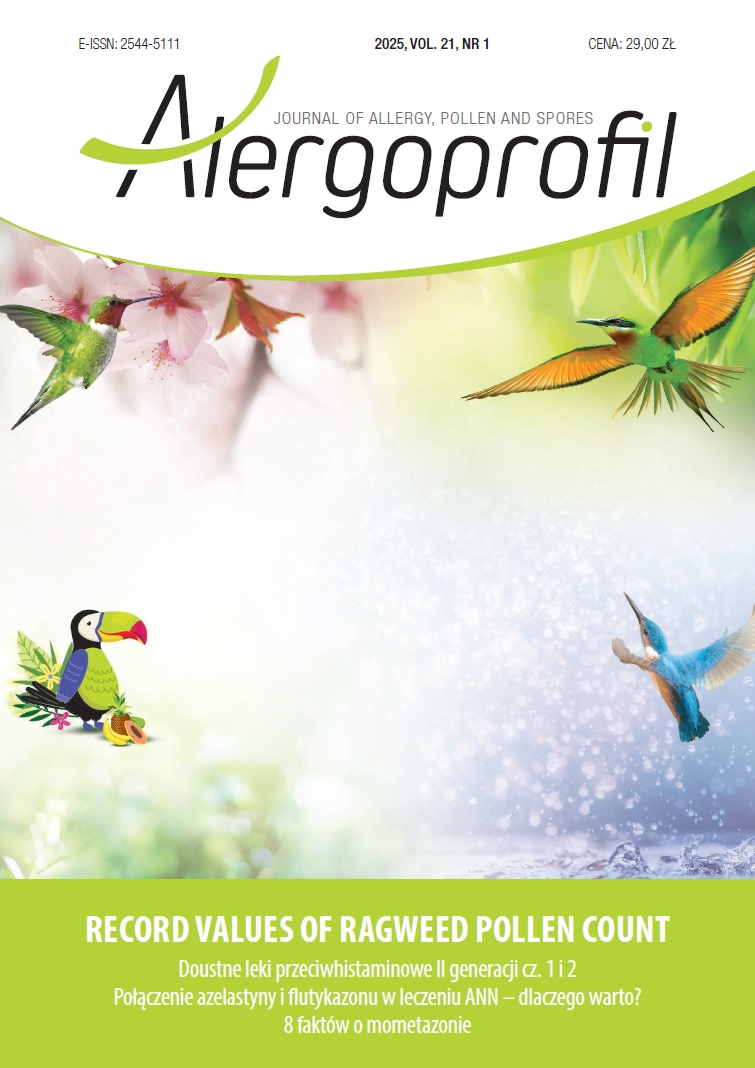8 facts about mometasone Review article
Main Article Content
Abstract
Intranasal corticosteroids are currently the most effective anti-inflammatory drugs in the treatment of allergic rhinitis. Advantage of Intranasal corticosteroids is their strong anti-inflammatory local action and little impact on general health. According to recommendations intranasal corticosteroids are considered the first line drugs for moderate and severe intermittent and all stages of persistent allergic rhinitis. In daily practice, we often wonder which of the available intranasal medicines will be the most effective, safest and comfortable for our patient to use. The paper presents distinguishing features of mometasone furoate
Downloads
Article Details

This work is licensed under a Creative Commons Attribution-NonCommercial 4.0 International License.
Copyright: © Medical Education sp. z o.o. This is an Open Access article distributed under the terms of the Attribution-NonCommercial 4.0 International (CC BY-NC 4.0). License (https://creativecommons.org/licenses/by-nc/4.0/), allowing third parties to copy and redistribute the material in any medium or format and to remix, transform, and build upon the material, provided the original work is properly cited and states its license.
Address reprint requests to: Medical Education, Marcin Kuźma (marcin.kuzma@mededu.pl)
References
2. Scadding GK. Intranasal corticosteroids in allergic rhinitis. Allergy. 2018; 73(5): 769-83.
3. Jurkiewicz D, Rapiejko P. Nieżyty nosa, zapalenie zatok przynosowych z polipami nosa. In: Alergologia w praktyce klinicznej. Część 2. Jahnz-Różyk K, Kupczyk M, Gawlik R (eds.). PZWL, Warszawa 2023.
4. Rot P, Rapiejko P, Jurkiewicz D. Intranasal steroid therapy – EPOS 2020. Otolaryngol Pol. 2020; 74(3): 41-9.
5. Brożek JL, Bousquet J, Baena‑Cagnani CE et al. Allergic rhinitis and its impact on asthma (ARIA) guidelines: 2010 revision. J Allergy Clin Immunol. 2010; 126: 466-76.
6. Meltzer EO, Bernstein DI, Prenner BM et al. Efficacy and safety of mometasone furoate nasal spray in seasonal allergic rhinitis. Clin Ther. 2017; 39(1): 182-90.
7. Greiner AN, Hellings PW, Rotiroti G et al. Allergic rhinitis. Lancet. 2018; 391(10138): 293-306.
8. Scadding GK. Optimal management of allergic rhinitis. Arch Dis Child. 2015; 100(6): 576-82.
9. Klimek L, Mullol J, Ellis AK et al. Current Management of Allergic Rhinitis. J Allergy Clin Immunol Pract. 2024; 12: 1399-412.
10. Wise SK, Damask C, Roland LT et al. International consensus statement on allergy and rhinology: Allergic rhinitis – 2023. Int Forum Allergy Rhinol. 2023; 13(4): 293-859.
11. Penagos M, Compalati E, Tarantini F et al. Efficacy of mometasone furoate nasal spray in the treatment of allergic rhinitis. Meta-analysis of randomized, double-blind, placebo-controlled, clinical trials. Allergy. 2008; 63(10): 1280-91.
12. Small CB, Hernandez J, Reyes A et al. Efficacy and safety of mometasone furoate nasal spray in nasal polyposis. J Allergy Clin Immunol. 2005; 116(6): 1275-81.
13. Wei CC, Kennedy DW. Mometasone implant for chronic rhinosinusitis. Med Devices (Auckl). 2012; 5: 75-80.
14. Passali D, Spinosi MC, Crisanti A et al. Mometasone furoate nasal spray: a systematic review. Multidiscip Respir Med. 2016; 11: 18.
15. Baena-Cagnani CE, Patel P. Efficacy and long-term safety of mometasone furoate nasal spray in children with perennial allergic rhinitis. Curr Med Res Opin. 2010; 26: 2047-55.
16. Baldwin CM, Scott LJ. Mometasone furoate. A review of its intranasal use in allergic rhinitis. Drugs. 2008; 68: 1723-39.
17. Schafer T, Schnoor M, Wagenmann M et al. Therapeutic Index (TIX) for intranasal corticosteroids in the treatment of allergic rhinitis. Rhinology. 2011; 49(3): 272-80.
18. Sousa-Pinto B, Jose Vieira R, Brozek J et al. Intranasal antihistamines and corticosteroids in allergic rhinitis: A systematic review and meta-analysis. J Allergy Clin Immunol. 2024; 154: 340-54.
19. Samoliński B, Arcimowicz M. (eds.). PoSLeNN. Alergologia Polska, 2012; S1: 1-167.
20. Salapatek AM, Patel P, Gopalan G et al. Mometasone furoate nasal spray provides early, continuing relief of nasal congestion and improves nasal patency in allergic patients. Am J Rhinol Allergy. 2010; 24: 433-8.
21. Charakterystyka Produktu Leczniczego. Momester.
22. Derendorf H, Meltzer EO. Molecular and clinical pharmacology of Intranasal corticosteroid: clinical and therapeutic implications. Allergy. 2008; 63: 1292-300.
23. Passalacqua G, Albano M, Canonica GW et al. Inhaled and nasal corticosteroids: safety aspects. Allergy. 2000; 55: 16-33.
24. Daley-Yates PT, Kunka RL, Yin Y et al. Bioavailability of fluticasone propionate and mometasone furoate aqueous nasal sprays. Eur J Clin Pharmacol. 2004; 60(4): 265-8.
25. Arcimowicz M. Skuteczne i bezpieczne leczenie alergicznego nieżytu nosa. Alergoprofil. 2015; 11(3): 11-22.
26. Minshall E, Ghaffar O, Cameron L et al. Assessment by Nasal Biopsy of Long-Term Use of Mometasone Furoate Aqueous Nasal Spray (Nasonex) in the Treatment of Perennial Rhinitis. Otolaryngol Head Neck Surg. 1998; 118: 648-54.
27. Sharpe SA, Sandweiss V, Tuazon J et al. Comparison of the flow properties of aqueous suspension corticosteroid nasal sprays under differing sampling conditions. Drug Dev Ind Pharm. 2003; 29: 1005‑12.
28. Rapiejko P, Sosnowski TR, Sova J et al. Deposition of intranasal glucocorticoids – preliminary study. Otolaryngol Pol. 2015; 69(6): 30‑8.
29. Sosnowski TR, Rapiejko P, Sova J et al. Impact of physicochemical properties of nasal spray products on drug deposition and transport in the pediatric nasal cavity model. Int J Pharm. 2020; 574: 118911.
